Clare Francis said:
“Ted Hupp and Kathryn Ball may very well feel like kissing David Argyle on both cheeks.”
That’s because when the pseudonymous image integrity sleuth heard of David Argyle’s bullying and the cover-up by the University of Edinburgh in Scotland, UK, Clare Francis started to screen Argyle’s papers for image irregularities. And soon stumbled over Argyle’s postdoc Lisa Pang, who did her PhD at the Cancer Research UK (CRUK) Edinburg Centre and MRC Institute of Genetics & Molecular Medicine under Ted Hupp, the US-born Edinburgh professor, who proved to be Argyle’s collaborator.
Right away, Clare Francis found a treasure trove of questionable research papers from Hupp’s lab. From Hupp’s papers, the sleuth stumbled upon another Edinburgh professor, Kathryn Ball, and her lab’s papers proved a treasure trove as well!
Hupp and Ball are in fact a husband-and-wife team, they both started together as PhD students at the Michigan State University in USA, moved together as postdocs to Scotland, both to the University of Dundee lab of Sir David Lane (who is now at Karolinska Institutet in Stockholm, Sweden, and not replying to emails). Hupp and Ball then both became professors at the same Institute of Genetics and Cancer by CRUK and MRC in Edinburgh. Both work on cell cycle regulation, he on p53, she on the p21 protein. Both sit on the scientific advisory board of the Scottish biotech startup ILC Therapeutics which seeks to cure with interferon drugs various diseases including COVID-19. Both published, together and separately, Photoshopped stuff they should be deeply ashamed for, and both remained silent when I contacted them.
I want to celebrate this power couple.
Here is how Clare Francis was led to playing the Hupp and Ball game. From Argyle to Pang to Hupp to Ball.
Lisa Y. Pang, Mary Scott , Richard L. Hayward , Hisham Mohammed , C. Bruce A. Whitelaw, Graeme C.M. Smith , Ted R. Hupp p21(WAF1) is component of a positive feedback loop that maintains the p53 transcriptional program Cell Cycle (2011) doi: 10.4161/cc.10.6.15012
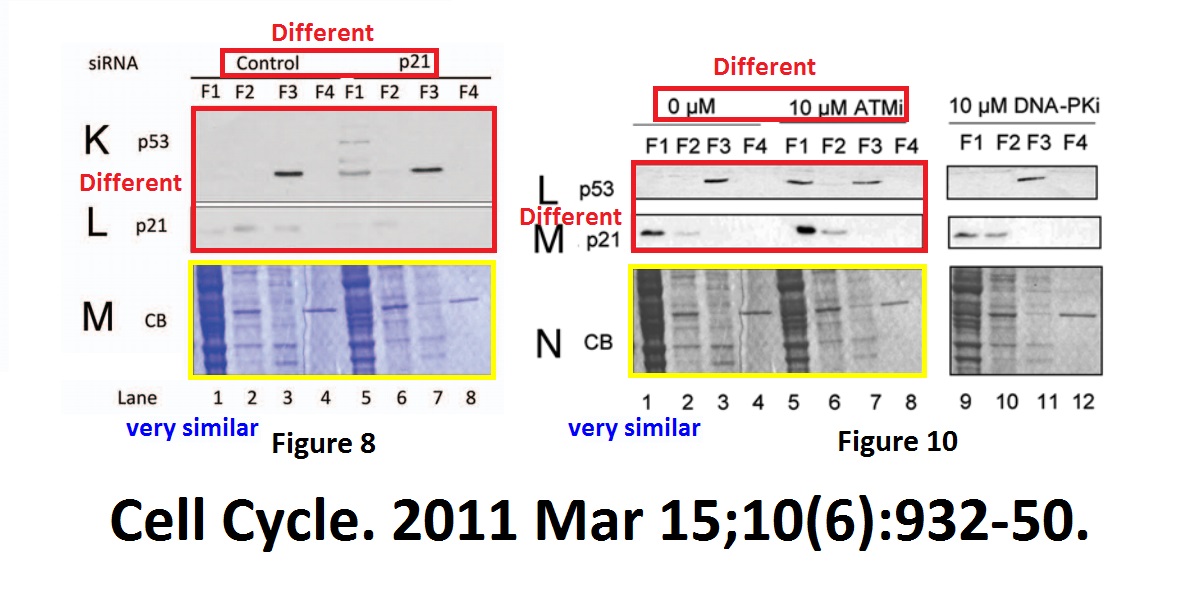
A Ponseau S blot image, “accidentally” reused, once in colour, once black-and-white, for two unrelated experiments. Why couldn’t the correct loading control be used? A mystery.
Here a paper by Hupp and Ball, rather old, raw data unavailable, but even Hupp agrees the gel is falsified:
Ashley Craig , Mary Scott , Lindsay Burch , Graeme Smith , Kathryn Ball, Ted Hupp Allosteric effects mediate CHK2 phosphorylation of the p53 transactivation domain EMBO reports (2003) doi: 10.1038/sj.embor.embor901
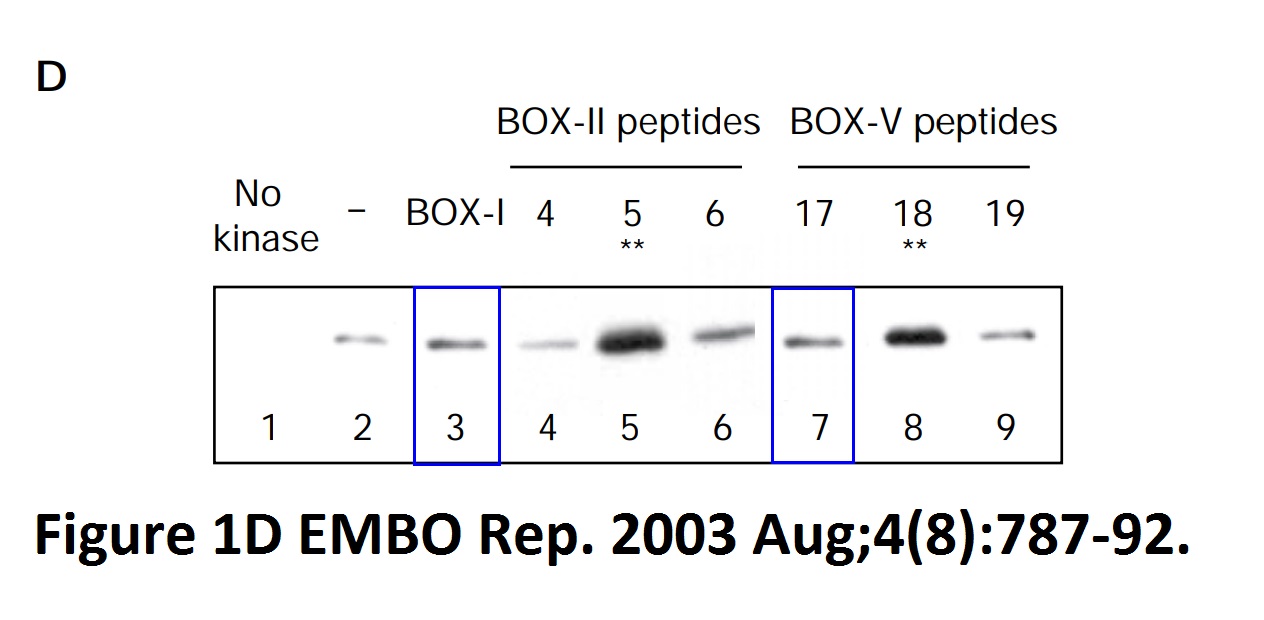
Hupp declared on PubPeer in June 2021:
“The authors think that the apparent similarity resulted from image crop/paste from different gels to condense key data from Fig 1d of the same paper, but the original data are no longer available for analysis. This particular image does not affect the overall data interpretation or the conclusions from the study; regarding stimulation of the chk2 kinase using synthetic peptides (named 5 and 18) that are the best binders to chk2 (fig 1d) so that there is a correlation between binding of peptides to chk2 and chk2 stimulation; the same chk2 stimulatory peptides were also reproduced in other data throughout the paper in question and these same peptides were also used as kinase stimulators reproduced in a follow up study (10.1128/MCB.01595-06) and towards another regulatory protein (10.1016/j.molcel.2006.05.029 ).“
Right-ho. It’s OK to fabricate results if you can reproduce them in your later papers. The first referenced study from Hupp’s lab has a blot duplication and a digitally assembled Chk1 gel, maybe the authors disapproved of the original results.
Ashley L. Craig , Jennifer A. Chrystal , Jennifer A. Fraser , Nathalie Sphyris , Yao Lin , Ben J. Harrison , Mary T. Scott , Irena Dornreiter , Ted R. Hupp The MDM2 ubiquitination signal in the DNA-binding domain of p53 forms a docking site for calcium calmodulin kinase superfamily members Molecular and Cellular Biology (2007) doi: 10.1128/mcb.01595-06
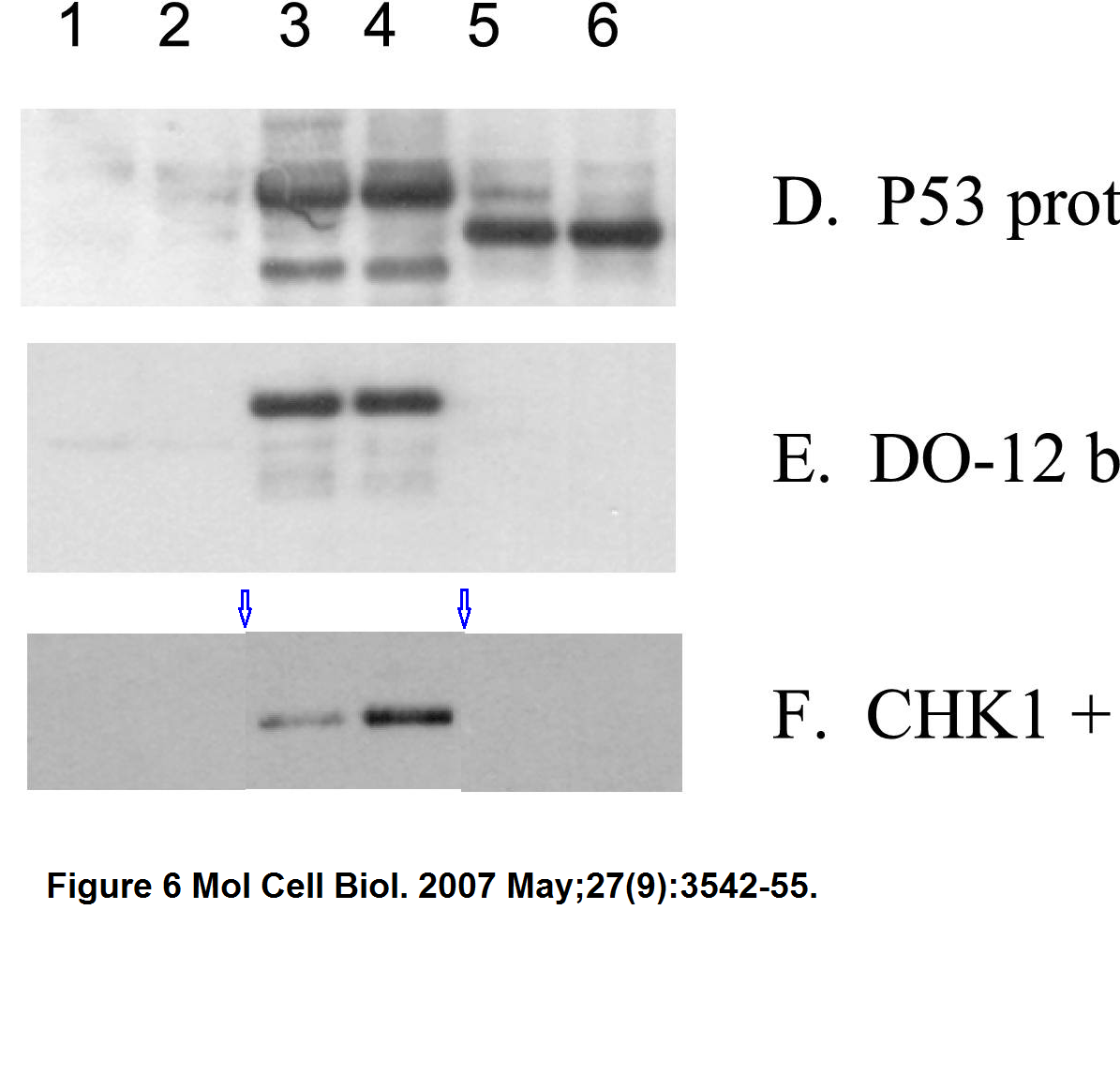
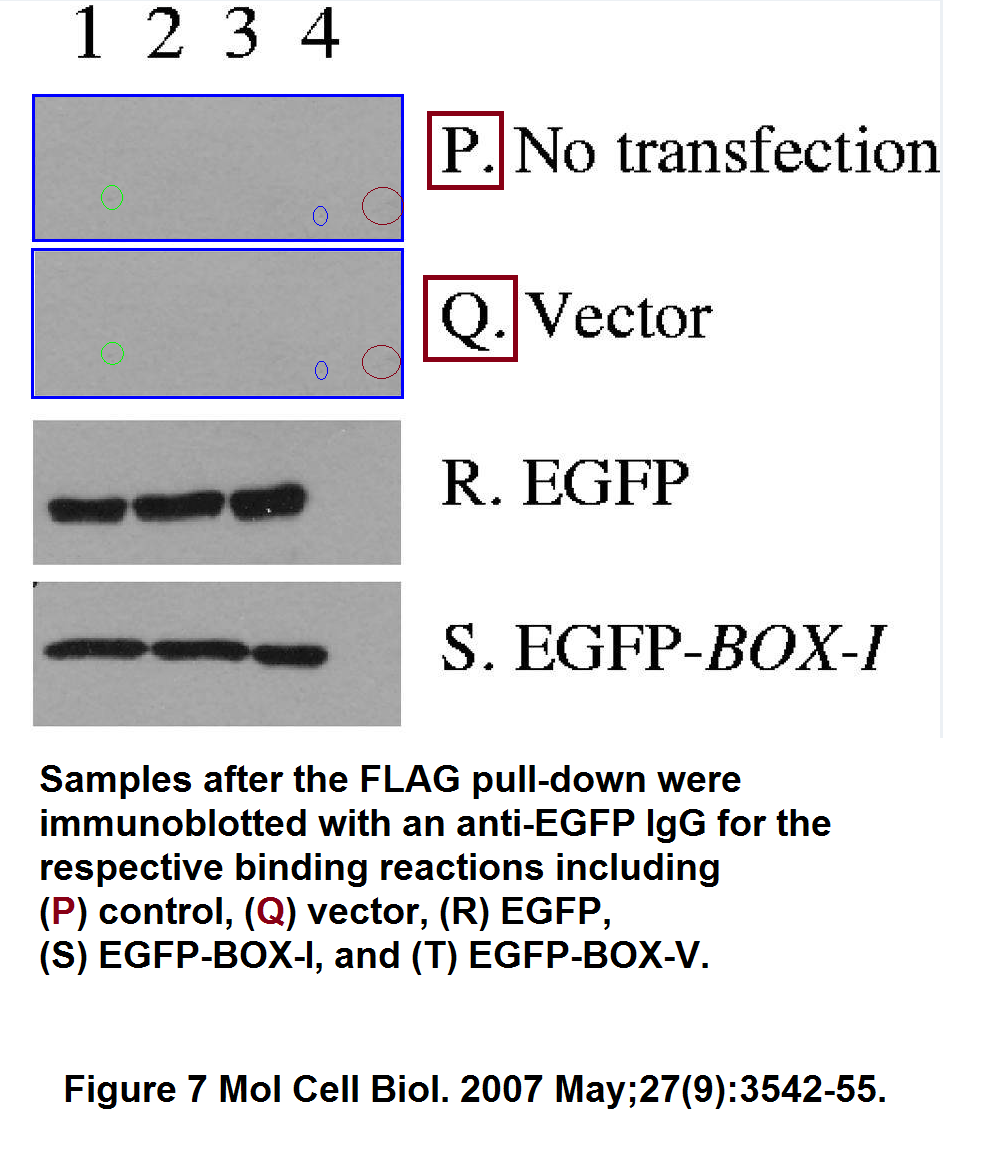
The second referenced paper by Hupp and Ball (Wallace et al 2006) hasn’t been yet commented upon on PubPeer, which under the circumstances of this story is no proof the paper is kosher.
What to make of the next paper though? Does any of this, uhm, reproducibility, affect the conclusions?
David Dornan , Mirjam Eckert , Maura Wallace, Harumi Shimizu, Eleanor Ramsay , Ted R. Hupp, Kathryn L. Ball Interferon regulatory factor 1 binding to p300 stimulates DNA-dependent acetylation of p53 Molecular and Cellular Biology (2004) doi: 10.1128/mcb.24.22.10083-10098.2004
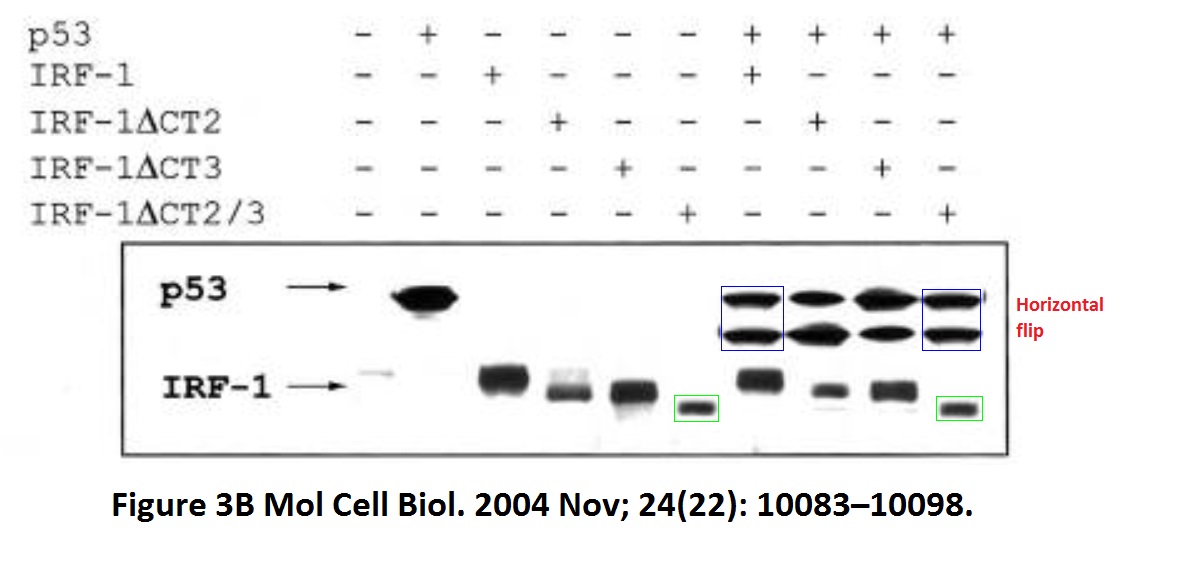

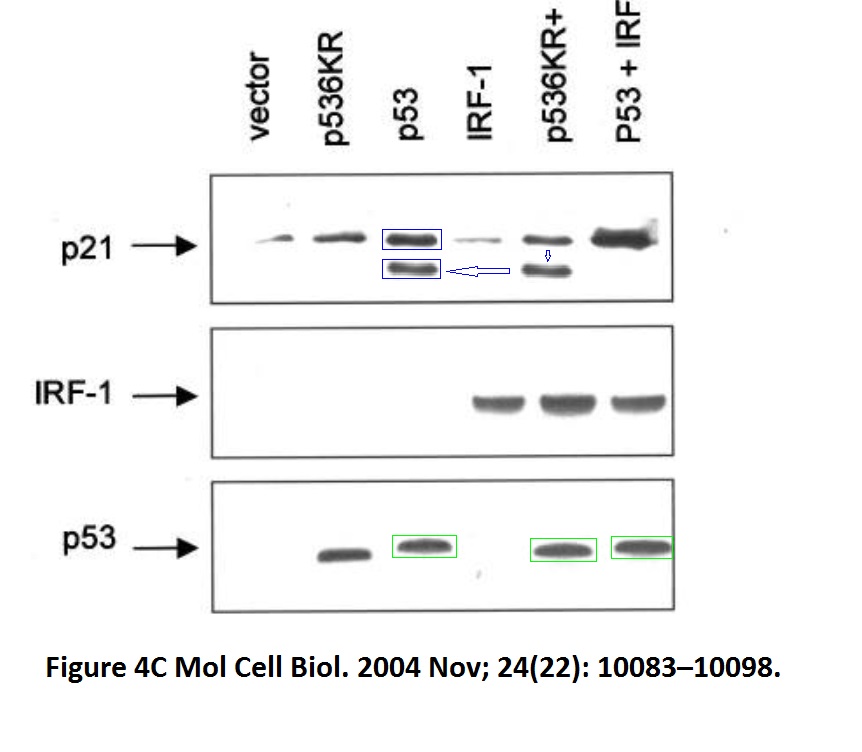
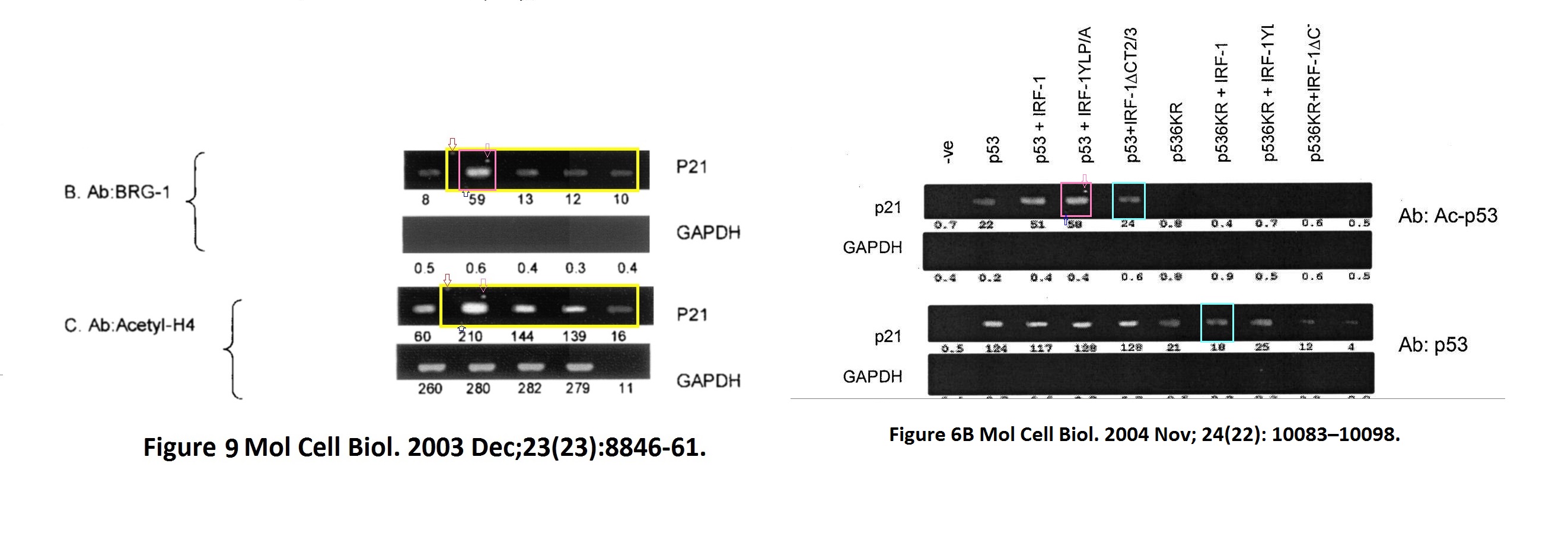

The first author David Dornan is Hupp’s former PhD student and now Chief Scientific Officer of Bolt Therapeutics, where he “is working to harness the exciting technologies at Bolt to discover and develop therapeutics that may exploit myeloid cell biology to generate a robust anti-tumor immune response.” He also didn’t reply to my email, and neither did Bolt.
Here is another example of what Dornan learned in the Hupp lab:
David Dornan , Harumi Shimizu , Lindsay Burch , Amanda J. Smith , Ted R. Hupp The proline repeat domain of p53 binds directly to the transcriptional coactivator p300 and allosterically controls DNA-dependent acetylation of p53 Molecular and Cellular Biology (2003) doi: 10.1128/mcb.23.23.8846-8861.2003
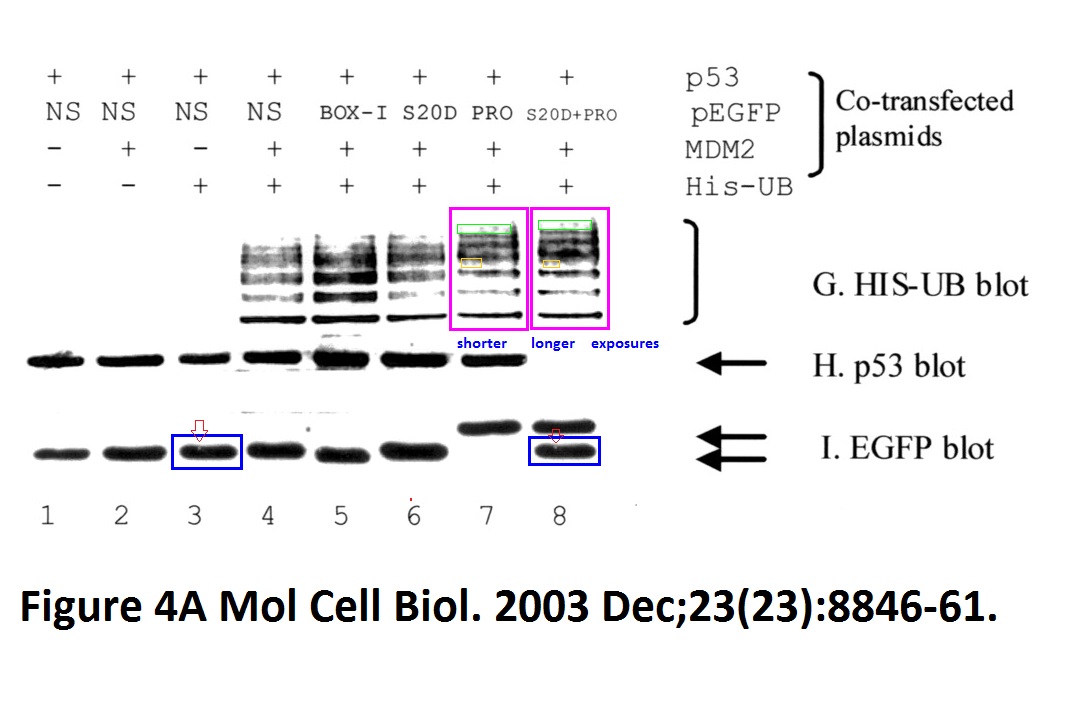
Hupp replied to this finding in June 2021 on PubPeer that yes, the gel is digitally falsified, but it was just a control:
“The authors feel that the apparent similarity likely resulted from mixing images cropped from different gels to assemble the final figure, but the original data could not be retrieved for analysis. This particular image was a negative control and does not affect the overall data interpretation or the conclusions from the study regarding interaction of p300 to proline-derived peptides, including deletion of the proline motifs of p53 that attenuate p300 functions (fig 5/6/7) and proline repeat domain protein promoter recruitment by chromatin ip (fig 8/9). The ability of proline repeat peptides to bind to p300 was also established by other studies (doi; 10.1074/jbc.M210696200; DOI; 10.1074/jbc.275.3.2115; DOI; 10.1016/j.jmb.2005.12.026; 10.1038/onc.2009.71).“
Basically, controls are also there to prove that you didn’t fudge up your experiment to get the result you wanted. Hupp and his mentee Dornan failed the test.
In any case, more was found in the Dornan et al 2003 study:
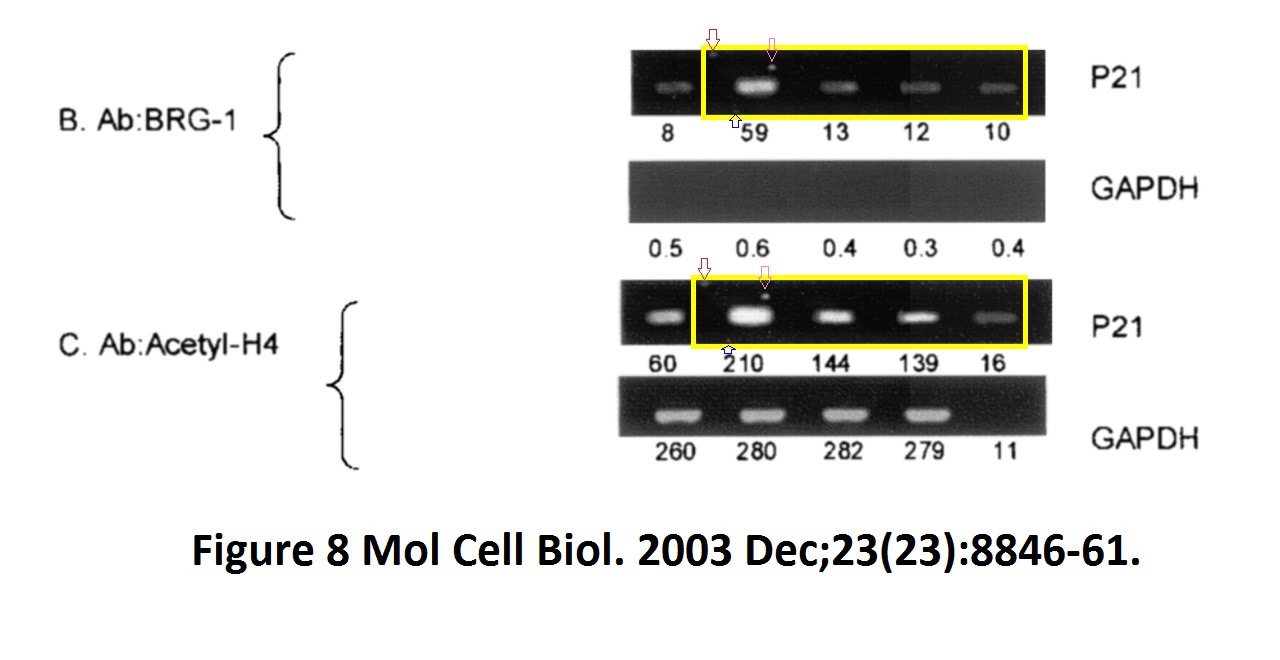
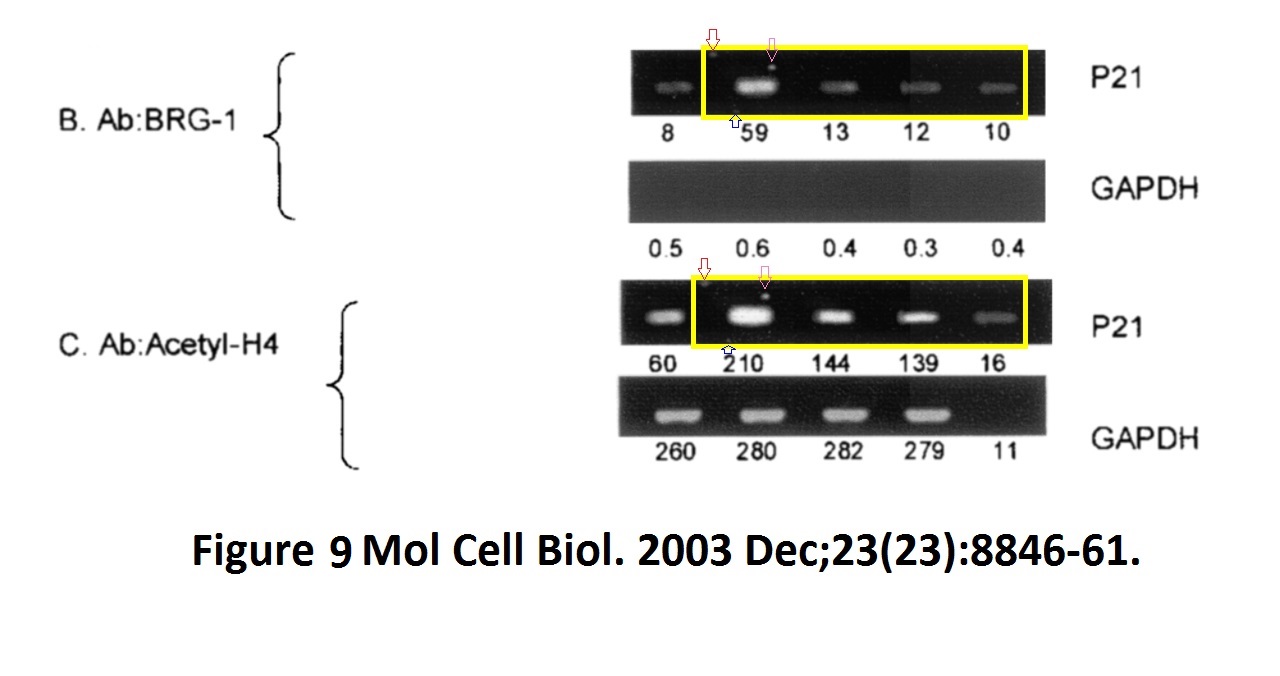
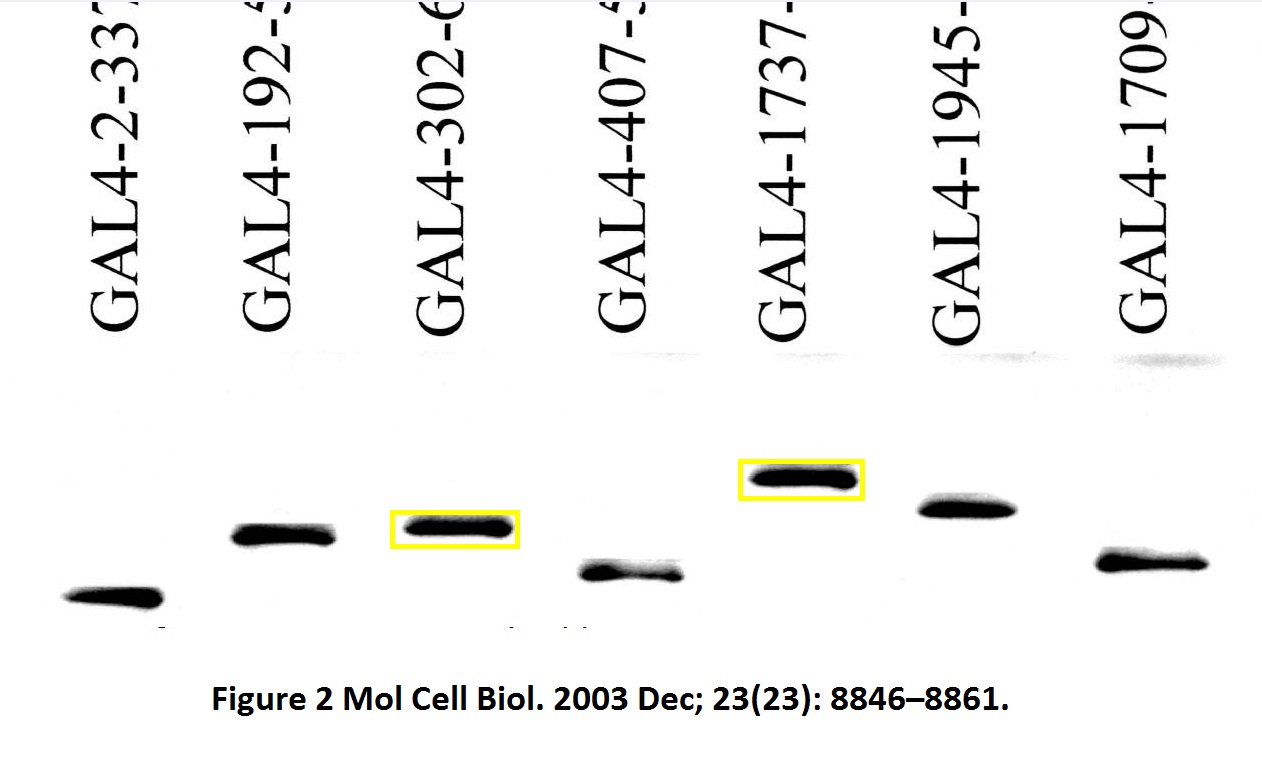

There, Hupp didn’t reply anymore. Also, that Dornan et al 2003 paper shares western blots bands with another Dornan et al 2003 paper:
David Dornan , Harumi Shimizu , Neil D. Perkins , Ted R. Hupp DNA-dependent acetylation of p53 by the transcription coactivator p300 Journal of Biological Chemistry (2003) doi: 10.1074/jbc.m211460200

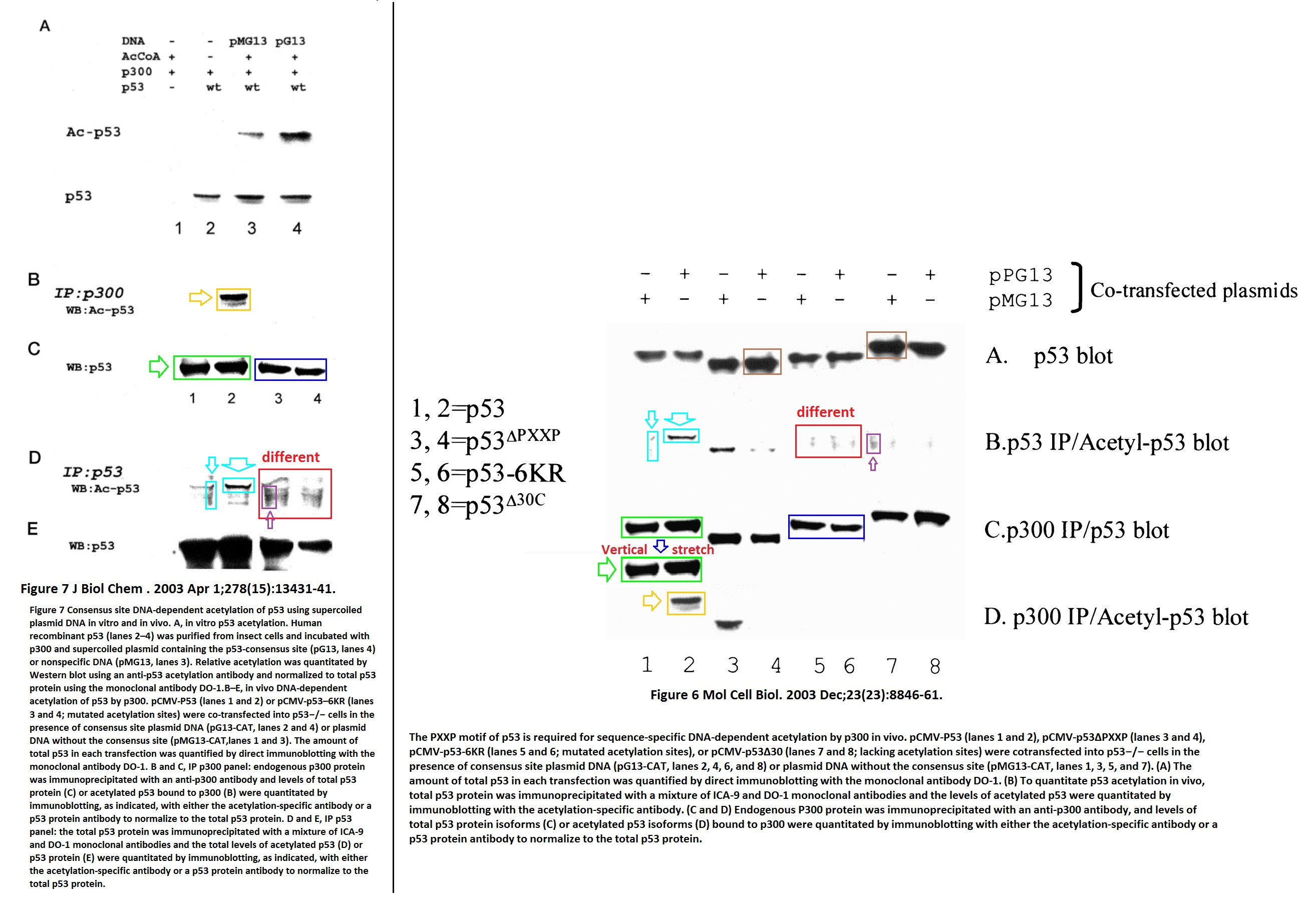
Neil Perkins, now that name rings a bell. Alarm bells, actually. In 2014, Perkins, then with the Wellcome Centre of University of Dundee, retracted 4 papers, and explained in this regard to Retraction Watch that a) his postdoc Benjamin Barré did it and b) he, Perkins, exposed this fraud all by himself (OK, together with Barre’s PhD mentor). However, Perkins had already at that time several other papers flagged on PubPeer, and those were not co-authored by Barré.
Perkins’ academic career trajectory is interesting. Having spent 12 years as Dundee professor, he suddenly had enough and went to University of Bristol in 2008, but stopped being professor there after less than 2 years. Since 2010, Perkins is with University of Newcastle, where he is now deputy dean of biosciences. Meaning, all misconduct allegations in the faculty go through Perkins’ desk.
Between Hupp and Ball, the husband is the bigger academic heavyweight. In 2017, Hupp (together with a French colleague) received €9.5 Million from the Foundation for Polish Science to set up the International Centre for Cancer Vaccine Science at the University of Gdansk. Hupp runs the Centre’s Twitter account, here is his dear collaborator, the bully Argyle, visiting (right):
Any moment now will Dr Hupp’s Photoshop technology produce a cancer vaccine. Now let’s have a look at what Dr Ball’s lab enriched the science with.
Mary T Scott , Angela Ingram , Kathryn L Ball PDK1-dependent activation of atypical PKC leads to degradation of the p21 tumour modifier protein The EMBO Journal (2002) doi: 10.1093/emboj/cdf684
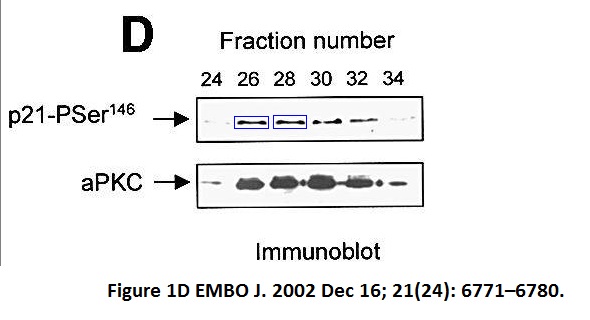
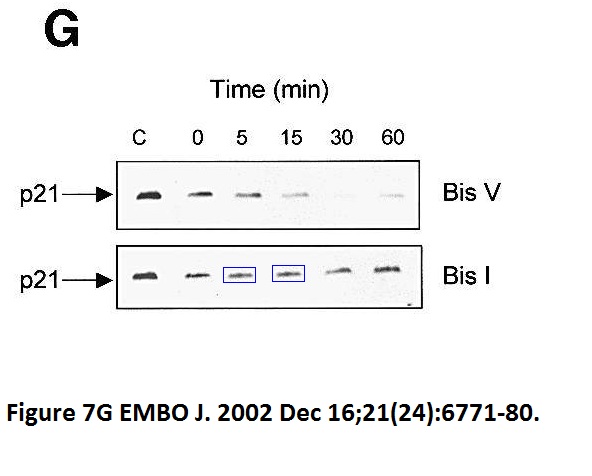
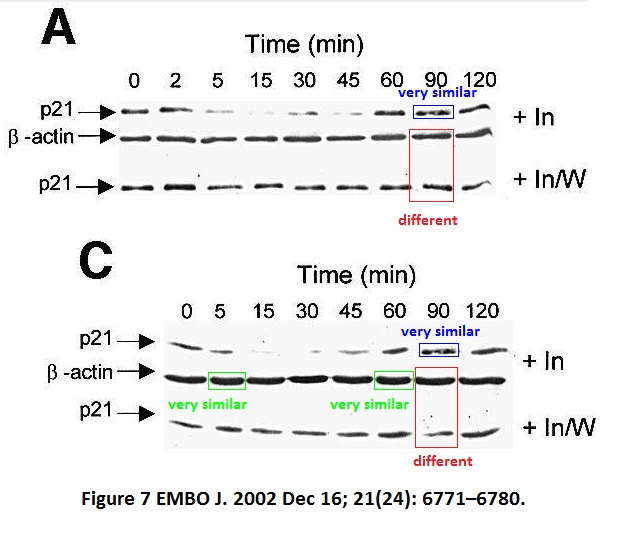
Maura Wallace used to head a unit at University of Edinburgh, a local newspaper once celebrated her receiving a charity donation for her cancer research. The charity money was put to good use.
Maura Wallace, Kathryn L. Ball Docking-dependent regulation of the Rb tumor suppressor protein by Cdk4 Molecular and Cellular Biology (2004) doi: 10.1128/mcb.24.12.5606-5619.2004




Well, at least we were spared Ball explaining on PubPeer that none of that data fabrication affected any conclusions, as her husband used to. Here a bit more of the Hupp and Ball game, courtesy of Clare Francis:
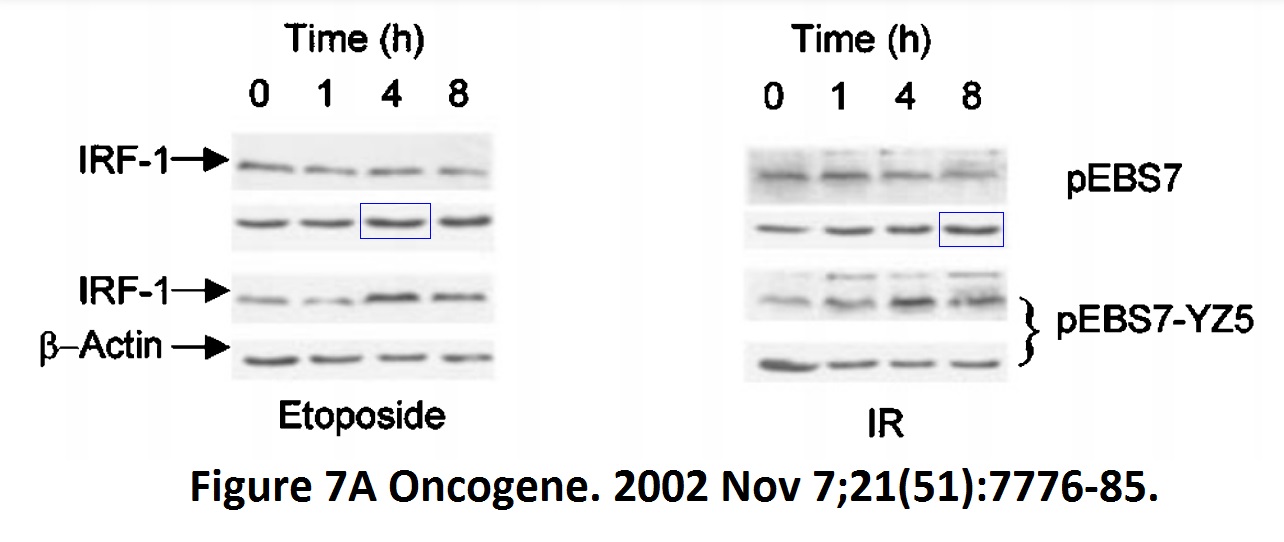




Now, you might say, well this all looks very serious. The University of Edinburgh sure won’t like it, a research misconduct investigation is probably already under way in full steam.
What are you, born yesterday and living the Moon? University of Edinburgh is not investigating anyone, in fact they refuse to admit any notifications of suspected research misconduct so they won’t have to open any investigations. Not on the dean of the veterinary faculty, the bully Argyle, and most certainly not on Hupp and Ball. Although, Edinburgh did investigate someone once, because the external pressure got too high and because the main perpetrator was a Bulgarian woman.
The senior lecturer Irina Stancheva was dismissed. All her partners in data forgery were absolved in full and enjoy their prestigious professorships at prestigious British universities on the virtue of being British males. Even Stancheva’s retractions were coordinated as not to hurt these important gentlemen.
The research integrity guidelines at Edinburgh state:
“Professor Jonathan Seckl, Vice-Principal Planning, Resources and Research Policy, is the main responsible contact for Research Misconduct. Professor Seckl delegates responsibility for research misconduct for each College.”
Seckl never replied to my notifications of course which bureaucratically means I never submitted anything. It is worth mentioning that Seckl is a collaborator of Moshe Szyf (here a questionable paper Weaver et al 2004), and also, the Edinburgh Vice-Principal can sympathise: his brother and Imperial College London professor Michael Seckl has a nice PubPeer record, including a retraction.
That retraction Michael Seckl earned together with Julian Downward, a somewhat controversial professor at The Crick. On the occasion of his other retraction, Downward explained to Retraction Watch that, let me check, yes, “Following a series of exhaustive London Research Institute (LRI) internal and external investigations, it was concluded” that also Dr Downward became a victim of a fraudulent foreigner he nourished at his bosom. A sad and tragic fate befalling many white British men of science.
There are no dirty foreigners to blame in our Hupp and Ball game (except yours truly), so you must understand why Michael Seckl’s brother Jonathan and his Edinburgh colleagues keep disregarding my email notifications. Plus, the Institute of Genetics and Molecular Medicine where Hupp and Ball work is part of College of Medicine and Veterinary Medicine, and its head Moira Whyte has vigorously defended Argyle from bullying complaints, including from a faculty member dying of cancer.
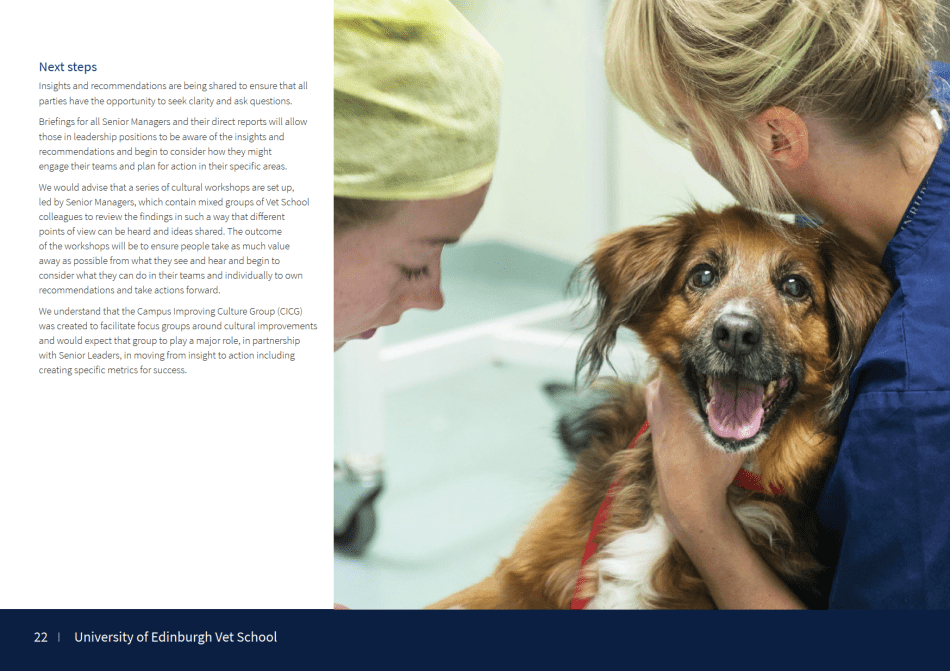
So you see, we up some hardened and ruthless opposition in Edinburgh. Don’t get fooled by the pictures of cuddly animals they deploy. These people will bite your head off if you get too close.
But evil as I am, I found a way in.
Edinburgh may refuse to admit my notification of suspected research misconduct, but I also contacted the University of Dundee, where the Hupp and Ball game originally began in the lab of Sir David Lane. I did this recalling how in 2016 Dundee cracked down on the science fraud by their former lecturer Robert Ryan. Ryan was made to resign, his funding withdrawn, and that despite Ryan’s alma mater University College Cork in Ireland aggressively defending his research, determined to protect at all costs their professor and Ryan’s mentor (and co-author) Maxwell Dow.
So I sent the PubPeer evidence to the University of Dundee, Right away, my notification was acknowledged with this message from Paul Davies, one of university’s research integrity leads:
“Thank you very much for raising this with the School of Life Sciences Research Integrity Group. As an Institution, we are proactively engaged in Research Integrity matters: we deal with the underlying causes of reproducibility issues in research and thoroughly evaluate all concerns and allegations of research misconduct involving our current and former researchers. We subscribe to PubPeer alerts (in fact we worked with PubPeer to enable searching by institution) and react to each one involving the University of Dundee. We are aware of the published comments you highlight and we are currently looking at these and will evaluate them thoroughly.“
Davies then announced to inform “all stakeholders, including the Journals, to establish the facts.” Which will first and foremost include the University of Edinburgh. Maybe Jonathan Seckl will have to grudgingly allow an investigation after all. Expect no misconduct findings though!

Nobody in Edinburgh is answering emails, and neither does Hupp’s and Ball’s mentor Sir David Lane in Stockholm. He should though, even one of his own papers is affected.
Kathryn L. Ball, David P. Lane Human and plant proliferating-cell nuclear antigen have a highly conserved binding site for the p53-inducible gene product p21WAF1 European Journal of Biochemistry (1996) doi: 10.1111/j.1432-1033.1996.0854p.x
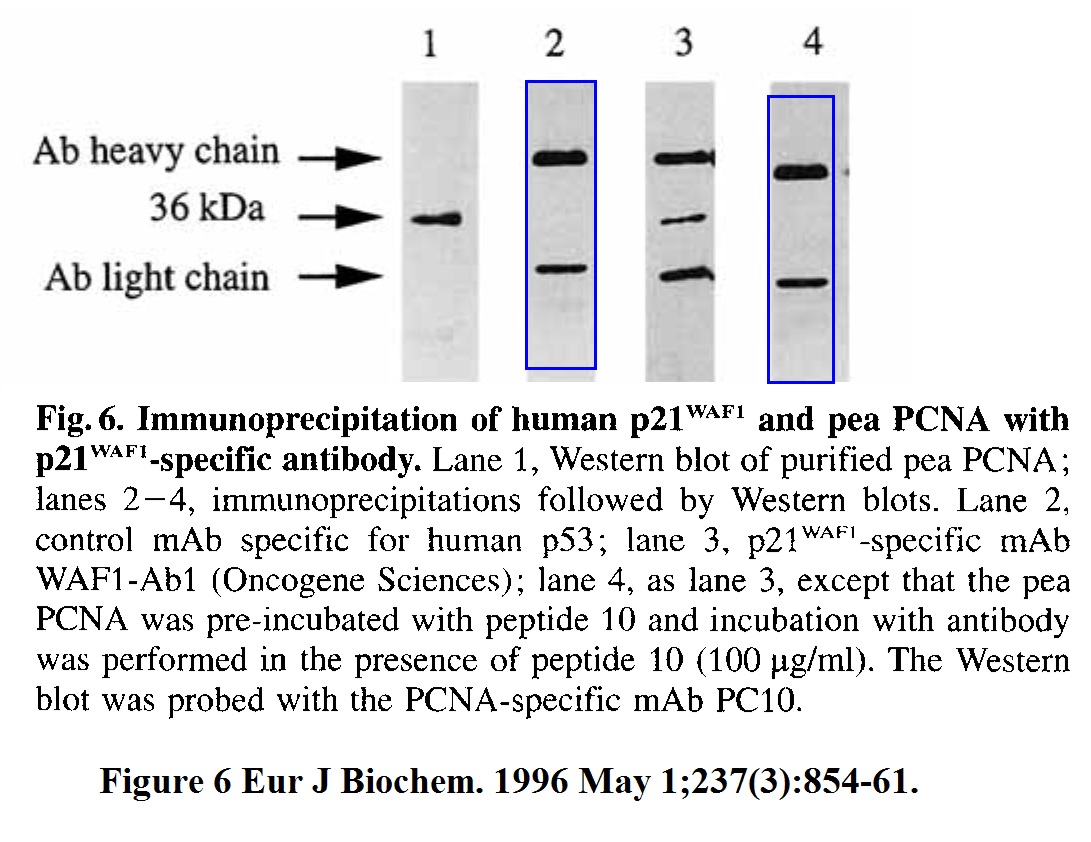


“[Jonathan] Seckl never replied to my notifications of course which bureaucratically means I never submitted anything. It is worth mentioning that Seckl is a collaborator of Moshe Szyf (here a questionable paper Weaver et al 2004)..”
This paper:
https://pubpeer.com/publications/B8213982BA13202EF2157FC41755BC
Cited 6574 times as of 02.01.2022 according to Google Scholar.
https://scholar.google.co.uk/scholar?hl=en&as_sdt=0%2C5&q=seckl+meaney+2004&oq=seckl+meaney
LikeLike
Chief Publishing Officer “Frontiers”, Mirjam Eckert, is author of a problematic publication with Ted Hupp and Kathryn Ball.
This paper:- https://pubpeer.com/publications/16180CE2482CFEBD624AEF605B1D20
Problematic data figures:-
2A, much more similar after vertical compression than expected.
3A, much more similar than expected,
3B, much more similar after horizontal flip than expected,
6B in itself and,
also, data in figure 6B seems to come from an earlier paper.
https://ch.linkedin.com/in/mirjam-eckert-ab391519/en
Experience
Frontiers
Frontiers
8 years 1 month
Chief Publishing Officer
Nov 2020 – Present1 year 3 months
Lausanne, Vaud, Switzerland
Publishing Director
Jan 2019 – Nov 20201 year 11 months
Lausanne Area, Switzerland
Editorial Director
Mar 2016 – Dec 20182 years 10 months
Lausanne und Umgebung, Schweiz
Editorial Office Manager
Nov 2014 – Mar 20161 year 5 months
Lausanne und Umgebung, Schweiz
Journal Manager
Jan 2014 – Oct 201410 months
Lausanne
Education
The University of Dundee
The University of Dundee Graphic
The University of Dundee
Doctor of Philosophy (PhD)Molecular Oncology
2002 – 2006
LikeLike
Eckert used to be known as Curno, and previously she was also board member and trustee at… COPE.
LikeLike
https://timesofmalta.com/articles/view/new-scientific-partnership-to-create-opportunities-for-cancer-research.866181
21 April 2021 Times of Malta
“Research Minister Owen Bonnici and Education Minister Justyne Caruana gave details about this collaboration, which aims at sharing new knowledge that results in innovative ways to treat cancer for immunotherapy to become more precise, personalised, and effective.”
“This scientific partnership was established thanks to the long-standing collaboration between David Saliba from the University of Malta and Ted Hupp, the director of the ICCVS.”
Research Minister Owen Bonnici and Education Minister Justyne Caruana should ask to see Ted Hupp’s data.
LikeLike
Oncogene . 1998 Oct 1;17(13):1691-703. doi: 10.1038/sj.onc.1202104.
Cell cycle arrest and DNA endoreduplication following p21Waf1/Cip1 expression
S Bates 1, K M Ryan, A C Phillips, K H Vousden
Affiliation
1
ABL Basic Research Program, NCI-FCRDC, Frederick, Maryland 21702-1201, USA.
PMID: 9796698 DOI: 10.1038/sj.onc.1202104
Problematic data figure 3(b). Much more similar than expected.
Pubpeer comments: https://pubpeer.com/publications/A0F7A3FFD9F1D6D44D149007691B32
K H Vousden presently: https://www.crick.ac.uk/research/find-a-researcher/karen-vousden
“moving back to the NCI in 1995, where she was Director of the Molecular Virology and Carcinogenesis Section at the ABL-Basic Research programme and then Chief of the Regulation of Cell Growth Laboratory.
In 2002, she returned to the UK to become the Director of the CRUK Beatson Institute in Glasgow, moving back to London in 2016 to take up the role of Chief Scientist at CRUK and Group Leader at the Francis Crick Institute.”
K M Ryan presently: https://www.beatson.gla.ac.uk/Cancer-Metabolism-Growth-and-Survival/kevin-ryan-tumour-cell-death.html
LikeLike
Reply to Leonid Schneider
January 8, 2022
I think it is like that. Occupy the leading positions, fuck the science!
LikeLike
Cell Signal. 2015 Sep;27(9):1816-23. doi: 10.1016/j.cellsig.2015.05.017. Epub 2015 Jun 9.
p70S6K is regulated by focal adhesion kinase and is required for Src-selective autophagy
Emma Sandilands 1, Christina Schoenherr 1, Margaret C Frame 2
Affiliations
1Edinburgh Cancer Research UK Centre, Institute of Genetics and Molecular Medicine, University of Edinburgh, Western General Hospital, Crewe Road South, Edinburgh EH4 2XR, United Kingdom.
2Edinburgh Cancer Research UK Centre, Institute of Genetics and Molecular Medicine, University of Edinburgh, Western General Hospital, Crewe Road South, Edinburgh EH4 2XR, United Kingdom.
Electronic address: m.frame@ed.ac.uk.
PMID: 26071201 PMCID: PMC4508348 DOI: 10.1016/j.cellsig.2015.05.017
Figure 1C. Much more similar than expected.
https://pubpeer.com/publications/128DB19432DF58596B3402D4F33AB6
LikeLike
https://www.ed.ac.uk/cancer-centre/research/myant-group
2008
LSH Cooperates with DNA Methyltransferases To Repress Transcription
Myant, K. & Stancheva, I., Jan 2008, In: Molecular and Cellular Biology. 28, 1, p. 215-226 12 p.
Research output: Contribution to journal › Article › peer-review
https://pubpeer.com/publications/63AED75DBD88BDDCF45E2AB23949F5
Figure 6B. Much more similar than expected.
LikeLike
“The senior lecturer Irina Stancheva was dismissed. All her partners in data forgery were absolved in full and enjoy their prestigious professorships at prestigious British universities on the virtue of being British males.”
https://www.artcraftcollective.co.uk/artists/irina-stancheva-studio-523-fused-glass-artist/
Irina Stancheva Studio 523 Fused Glass Artist
“After working in academic science for more than 20 years, I decided to try something new and exciting. I set up a studio for fused glass work and now I am having a lot of fun designing and making variety of fused glass objects and jewellery.
Glass is an amazing material, which interacts with light in many interesting ways and offers infinite possibilities to explore combinations of colors, transparency, shape and texture. My science background also comes useful when considering chemical reactions that occur between different kinds of glass and metals when they melt and blend with each other in the kiln. My fused glass creations are inspired by nature and often by what I see when I walk to my studio.
I am happy to teach anyone in my studio, so get in touch if you are interested in fused glass and would like to make something beautiful.”
We have a range of Irina’s work in the Gallery, from hanging ‘fish’ to tealight holders, decorative (and practical) plates and bowls.
Irina is also more than happy to discuss commissions so please contact her directly or through the Gallery.”
Might Kathryn Ball and Ted Hupp consider fused glass?
Note that Irina Stancheva writes:
“I am happy to teach anyone in my studio, so get in touch if you are interested in fused glass and would like to make something beautiful”.
LikeLike
Mol Cancer Ther . 2003 Nov;2(11):1121-8.
Replication and episomal maintenance of Epstein-Barr virus-based vectors in mouse embryonal fibroblasts enable synthetic lethality screens
https://mct.aacrjournals.org/content/2/11/1121.article-info
AUTHOR INFORMATION
Yulia Einav 1, Elena Shistik 1, Michal Shenfeld 1, Arnold H. Simons 1, David W. Melton 2 and Dan Canaani 1
1Department of Biochemistry, The George S. Wise Faculty of Life Sciences, Tel Aviv University, Ramat Aviv, Israel and
2Sir Alastair Currie Cancer Research UK Laboratories, Molecular Medicine Centre, University of Edinburgh, Edinburgh, UK
Requests for Reprints: Dan Canaani, Department of Biochemistry, George S. Wise Faculty of Life Sciences, Tel Aviv University, Ramat Aviv 69978, Israel. Phone: 972-3-6408985; Fax: 972-3-6424270. E-mail: canaani@post.tau.ac.il
PMID: 14617785
Problematic data figures 2A and 2B.
Figure 2A. Much more similar than expected.
Figure 2B. Much more similar than expected.
LikeLike
Mol Cell Biol . 2003 Dec;23(24):9245-50. doi: 10.1128/MCB.23.24.9245-9250.2003.
While K-ras is essential for mouse development, expression of the K-ras 4A splice variant is dispensable
Sarah J Plowman 1, D James Williamson, Maureen J O’Sullivan, Jennifer Doig, Ann-Marie Ritchie, David J Harrison, David W Melton, Mark J Arends, Martin L Hooper, Charles E Patek
Affiliation
1
Sir Alastair Currie Cancer Research UK Laboratories, Molecular Medicine Centre, Western General Hospital, Crewe Road, Edinburgh EH4 2XU, Scotland, U.K.
PMID: 14645534 PMCID: PMC309700 DOI: 10.1128/MCB.23.24.9245-9250.2003
Problematic data figure 4, middle panel, much more similar than expected.
LikeLike
Additional problematic data Mol Cell Biol . 2003 Dec;23(24):9245-50. doi: 10.1128/MCB.23.24.9245-9250.2003.
Problematic data figure 2B. Much more similar than expected.
LikeLike
More problematic data figure 4 Mol Cell Biol . 2003 Dec;23(24):9245-50. doi: 10.1128/MCB.23.24.9245-9250.2003.
Figure 4, middle panel. Much more similar than expected. This time inside the light blue rectangles.
LikeLike
Yet more problematic data figure 4 Mol Cell Biol . 2003 Dec;23(24):9245-50. doi: 10.1128/MCB.23.24.9245-9250.2003.
Problematic data figure 4 bottom panel. Much more similar than expected.
LikeLike
Exp Cell Res . 2006 Jan 1;312(1):16-26. doi: 10.1016/j.yexcr.2005.10.004. Epub 2005 Nov 4.
The K-Ras 4A isoform promotes apoptosis but does not affect either lifespan or spontaneous tumor incidence in aging mice
Sarah J Plowman 1, Mark J Arends, David G Brownstein, Feijun Luo, Paul S Devenney, Lorraine Rose, Ann-Marie Ritchie, Rachel L Berry, David J Harrison, Martin L Hooper, Charles E Patek
Affiliation
1
Sir Alastair Currie Cancer Research UK Laboratories, Molecular Medicine Centre, The University of Edinburgh, Western General Hospital, Crewe Road, Edinburgh EH4 2XU, UK.
PMID: 16271715 DOI: 10.1016/j.yexcr.2005.10.004
Problematic data figure 1B. Much more similar than expected.
LikeLike
Data in Nucleic Acids Res. 2001 Nov 15; 29(22): 4541–4550 reappears in
Transgenic Res . 2011 Feb;20(1):109-22. doi: 10.1007/s11248-010-9396-3. Epub 2010 Apr 21.
The figure 1 legend Transgenic Res . 2011 Feb;20(1):109-22 does not state that the data have appeared earlier.
Transgenic Res . 2011 Feb;20(1):109-22 claims to be an ORIGINAL PARER.
The text of Transgenic Res . 2011 Feb;20(1):109-22 does mention Selfridge et al. 2001 in the text, but does not state that the data are the same.
“A panel of tissues from a wild-type BALB/c adult male mouse was analysed by Northern blotting using an Ercc1 cDNA probe (Probe a in Selfridge et al. 2001).”
1. Nucleic Acids Res. 2001 Nov 15; 29(22): 4541– 4550.doi: 10.1093/nar/29.22.4541PMCID:
PMC92547PMID: 11713303
Correction of liver dysfunction in DNA repair-deficient mice with an ERCC1 transgene
Jim Selfridge, Kan-Tai Hsia, Nicola J. Redhead,1 and David W. Melton1,a
Author information
Institute of Cell and Molecular Biology, University of Edinburgh, King’s Buildings, Mayfield Road, Edinburgh EH9 3JR, UK and
1Sir Alastair Currie CRC Laboratories, Molecular Medicine Centre, University of Edinburgh, Western General Hospital, Crewe Road, Edinburgh EH4 2XU, UK
a To whom correspondence should be addressed. Tel: +44 131 651 1079; Fax: +44 131 651 1072;
Email: david.melton@ed.ac.uk
Present address: Kan-Tai Hsia, Faculty of Dentistry, National Yang-Ming University, Taiwan, Republic of China.
2. Transgenic Res . 2011 Feb;20(1):109-22. doi: 10.1007/s11248-010-9396-3. Epub 2010 Apr 21.
A novel transcript for DNA repair gene Ercc1 in mouse skin
L Song 1, A G Winter, J Selfridge, D W Melton
Affiliations
1Institute of Genetics and Molecular Medicine, MRC Human Genetics Unit, Western General Hospital, University of Edinburgh, Crewe Road, Edinburgh, EH4 2XU, UK.
PMID: 20407824 DOI: 10.1007/s11248-010-9396-3
LikeLike
Transgenic Res. 2011 Feb;20(1):109-22. doi: 10.1007/s11248-010-9396-3. Epub 2010 Apr 21.
Figure 2. Much more similar than expected.
LikeLike
More data in Transgenic Res . 2011 Feb;20(1):109-22. doi: 10.1007/s11248-010-9396-3. Epub 2010 Apr 21
very similar to data in
Nucleic Acids Res. 2001 Nov 15; 29(22): 4541–4550
LikeLike
https://www.frontiersofknowledgeawards-fbbva.es/jurado/bruce-whitelaw-2/
“Bruce Whitelaw holds the Genus Personal Chair of Animal Biotechnology at the Royal (Dick) School of Veterinary Studies (RDSVS) of the University of Edinburgh. He is also Interim Director of the same university’s Roslin Institute.”
” former editor-in-chief of Transgenic Research” failed to recognise problematic data in his own publications:-
https://pubpeer.com/publications/8CE988307EBAA1F791A99AB678C107
https://pubpeer.com/publications/AF4153D2BBECB11405DF1300D71678
Mystery for Authur Conan Doyle (born Edinburgh) to solve.
“cardiac directed differentiation of canine adult cardiac stem cells”
https://pubpeer.com/publications/16D3D122C6F2B5A6784AD465745419
LikeLike
Data Development. 2003 Jan;130(2):369-78 very similar to data in Nucleic Acids Res. 2001 Nov 15;29(22):4541-50. doi: 10.1093/nar/29.22.4541.
FYI: Development . 2003 Jan;130(2):369-78. doi: 10.1242/dev.00221.
DNA repair gene Ercc1 is essential for normal spermatogenesis and oogenesis and for functional integrity of germ cell DNA in the mouse
Kan-Tai Hsia 1, Michael R Millar, Sasha King, Jim Selfridge, Nicola J Redhead, David W Melton, Philippa T K Saunders
Affiliation
1Institute of Cell and Molecular Biology, University of Edinburgh, King’s Buildings, Mayfield Road, Edinburgh EH9 3JR, UK.
PMID: 12466203 DOI: 10.1242/dev.00221
LikeLike
J Mol Biol . 2004 Mar 12;337(1):115-28. doi: 10.1016/j.jmb.2003.10.081.
Phage-peptide display identifies the interferon-responsive, death-activated protein kinase family as a novel modifier of MDM2 and p21WAF1
Lindsay R Burch 1, Mary Scott, Elizabeth Pohler, David Meek, Ted Hupp
Affiliation
1
Cancer Research UK Laboratories, Department of Molecular and Cellular Pathology, University of Dundee, Dundee DD1 9SY, Scotland, UK.
PMID: 15001356 DOI: 10.1016/j.jmb.2003.10.081
Problematic data figure 4D. Vertical, straight change in signal between – and + lanes. There are only 2 lanes.
LikeLike
Mol Cell Biol. 2002 Jul; 22(14): 5141–5156.doi: 10.1128/MCB.22.14.5141-5156.2002PMCID: PMC139773PMID: 12077342
Mammalian PRP4 Kinase Copurifies and Interacts with Components of Both the U5 snRNP and the N-CoR Deacetylase Complexes
Graham Dellaire,1 Evgeny M. Makarov,2 JeffJ.M. Cowger,3 Dasa Longman,1 Heidi G. E. Sutherland,1 Reinhard Lührmann,2 Joseph Torchia,3 and Wendy A. Bickmore1,*
Author information
MRC-Human Genetics Unit, Western General Hospital, Edinburgh, United Kingdom,1
Department of Cellular Biochemistry, Max-Planck-Institute for Biophysical Chemistry, Gottingen, Germany,2
and Toxicology and Oncology, Cancer Research Laboratories, London Regional Cancer Centre, The University of Western Ontario, London, Ontario, Canada3
*Corresponding author. Mailing address: MRC-Human Genetics Unit, Western General Hospital, Crewe Road, Edinburgh EH4 2XU, United Kingdom. Phone: 44 (131) 467-8418. Fax: 44 (131) 343-2620.
E-mail: Wendy.Bickmore@hgu.mrc.ac.uk
Presently:https://www.ed.ac.uk/profile/wendy-bickmore
Professor Wendy Bickmore (FRS FMedSci FRSE)
Director – MRC Human Genetics Unit
Email: hgu.director@ed.ac.uk
Problematic data figure 5C. Much more similar than expected. Also, vertical, straight change in signal in one panel, but not in the other.
Problematic data figure 8B. Much more similar than expected.
Problematic data figure 5A. Vertical, straight change in signal in one panel, but not in the other.
LikeLike
Science. 1992 Jul 10;257(5067):235-7. doi: 10.1126/science.1321494.
Modulation of DNA binding specificity by alternative splicing of the Wilms tumor wt1 gene transcript
W A Bickmore 1, K Oghene, M H Little, A Seawright, V van Heyningen, N D Hastie
Affiliation
1Medical Research Council Human Genetics Unit, Western General Hospital, Edinburgh, Scotland.
PMID: 1321494 DOI: 10.1126/science.1321494
Figure 4. Vertical, straight line between lanes 2 and 3 in +P2 panel, and vertical, straight line/change in background between lanes 3 and 4 in +P5 panel. This makes it less clear of the Electrophoretic mobility-shift assays in those panels have been run in the same gel. It was more common to splice data in those days, but for reasons such as running out of lanes. There are only 4 lanes in each of the panels shown.
LikeLike
Mol Biol Cell 2009 Mar;20(6):1845-54. doi: 10.1091/mbc.e08-09-0944. Epub 2009 Jan 21.
The hydrophobic cysteine-rich domain of SNAP25 couples with downstream residues to mediate membrane interactions and recognition by DHHC palmitoyl transferases
Jennifer Greaves 1, Gerald R Prescott, Yuko Fukata, Masaki Fukata, Christine Salaun, Luke H Chamberlain
Affiliation
1Centre for Integrative Physiology, School of Biomedical Sciences, University of Edinburgh, Edinburgh EH8 9XD, United Kingdom.
PMID: 19158383 PMCID: PMC2655257 DOI: 10.1091/mbc.e08-09-0944
Figure 9. Much more similar than expected.
LikeLike
Nat Genet . 2010 Jan;42(1):89-93. doi: 10.1038/ng.494. Epub 2009 Dec 20.
Wt1 is required for cardiovascular progenitor cell formation through transcriptional control of Snail and E-cadherin
Ofelia M Martínez-Estrada 1, Laura A Lettice, Abdelkader Essafi, Juan Antonio Guadix, Joan Slight, Víctor Velecela, Emma Hall, Judith Reichmann, Paul S Devenney, Peter Hohenstein, Naoki Hosen, Robert E Hill, Ramón Muñoz-Chapuli, Nicholas D Hastie
Affiliation
1
MRC Human Genetics Unit and Institute for Genetics and Molecular Medicine, Edinburgh, UK.
PMID: 20023660 PMCID: PMC2799392 DOI: 10.1038/ng.494
Problematic data figure 2i. Much more similar than expected.
LikeLike
Cardiovasc Res . 2005 Feb 1;65(2):328-33. doi: 10.1016/j.cardiores.2004.11.015.
Human adipose tissue as a source of Flk-1+ cells: new method of differentiation and expansion
Ofelia María Martínez-Estrada 1, Yolanda Muñoz-Santos, Josep Julve, Manuel Reina, Senén Vilaró
Affiliations
1Departament de Biologia Cellular, Facultat Biologia, Universitat de Barcelona, Ave Diagonal, 645 E-08028 Barcelona, Spain.
ofeliamartinez@ub.eduPMID:
15639471 DOI: 10.1016/j.cardiores.2004.11.015
Figures 2C and 2D size of cell clusters does not appear to be bigger (just a higher magnification).
LikeLike
https://www.pcb.ub.edu/en/the-pcb-deeply-regrets-the-death-of-senen-vilaro/
05.12.2005
The PCB deeply regrets the death of Senén Vilaró
The Fundació Parc Científic de Barcelona deeply regrets the loss of our colleague and friend Senén Vilaró i Coma, professor of Cellular Biology at the Universitat de Barcelona and chief executive of Advancell.
As a founder of Advancell, the first spin-off from the UB and located at the PCB, Senén Vilaró was a pioneering researcher in entrepreneurship and knowledge transfer. He will be greatly missed by all those who work at the Park.
Another case of dishonoring the dead?
https://forbetterscience.com/2022/01/04/who-killed-margarita-lorenzos-reputation/
LikeLike
Biochem J . 2006 Mar 1;394(Pt 2):449-57. doi: 10.1042/BJ20050591.
The transcription factors Slug and Snail act as repressors of Claudin-1 expression in epithelial cells
Ofelia M Martínez-Estrada 1, Albert Cullerés, Francesc X Soriano, Hector Peinado, Victoria Bolós, Fernando O Martínez, Manuel Reina, Amparo Cano, Myriam Fabre, Senén Vilaró
Affiliation
1Departament de Biologia Cellular, Facultat de Biologia, Universitat de Barcelona, Barcelona, Spain.
ofeliamartinez@ub.edu
PMID: 16232121
https://pubpeer.com/publications/0BE518183A2869E59EE898BA4426CE
Figure 5. Much more similar than expected.
Figure 2F. Much more similar than expected.
LikeLike
Spot the difference!
Ann N Y Acad Sci . 2004 Dec;1032:63-84. doi: 10.1196/annals.1314.006.
Glucocorticoid programming
Jonathan R Seckl 1, Michael J Meaney
Affiliation
1Endocrinology Unit, University of Edinburgh, Molecular Medicine Centre, Western General Hospital, Edinburgh, EH4 2XU, UK. J.Seckl@ed.ac.uk
PMID: 15677396
DOI: 10.1196/annals.1314.006
Abstract
Epidemiological evidence suggests that an adverse fetal environment permanently programs physiology, leading to increased risks of cardiovascular, metabolic, and neuroendocrine disorders in adulthood. Prenatal glucocorticoid excess or stress might link fetal maturation and adult pathophysiology. In a variety of animal models, prenatal glucocorticoid exposure or inhibition of 11beta-hydroxysteroid dehydrogenase type 2 (11beta-HSD2), the fetoplacental “barrier” to maternal glucocorticoids, reduces birth weight and causes permanent hypertension, hyperglycemia, and increased hypothalamic-pituitary-adrenal axis (HPA) activity and behavior resembling anxiety. In humans, 11beta-HSD2 gene mutations cause low birth weight and reduced placental 11beta-HSD2 activity associated with intrauterine growth retardation. Low birth weight babies have higher plasma cortisol levels throughout adult life, indicating HPA programming. The molecular mechanisms may reflect permanent changes in the expression of specific transcription factors; key is the glucocorticoid receptor itself. Differential programming of the glucocorticoid receptor in different tissues reflects effects upon one or more of the multiple tissue-specific alternate first exons/promoters of the glucocorticoid receptor gene. Overall, the data suggest that either pharmacological or physiological exposure to excess glucocorticoids prenatally programs pathologies in adult life.
Eur J Endocrinol . 2004 Nov;151 Suppl 3:U49-62. doi: 10.1530/eje.0.151u049.
Prenatal glucocorticoids and long-term programming
Jonathan R Seckl 1
Affiliation
1Endocrinology Unit, University of Edinburgh, Western General Hospital, Edinburgh EH4 2XU, UK. J.Seckl@ed.ac.uk
PMID: 15554887
DOI: 10.1530/eje.0.151u049
Abstract
Epidemiological evidence suggests that low birth weight is associated with an increased risk of cardiovascular, metabolic and neuroendocrine disorders in adult life. Glucocorticoid administration during pregnancy reduces offspring birth weight and alters the maturation of the lung and other organs. We hypothesised that prenatal exposure to excess glucocorticoids or stress might represent a mechanism linking foetal growth with adult pathophysiology. In rats, birth weight is reduced following prenatal exposure to the synthetic steroid dexamethasone, which readily crosses the placenta, or to carbenoxolone, which inhibits 11beta-hydroxysteroid dehydrogenase type 2 (11beta-HSD2), the physiological feto-placental ‘barrier’ to maternal glucocorticoids. As adults, the offspring exhibit permanent hypertension, hyperglycaemic, increased hypothalamic-pituitary-adrenal (HPA) axis activity and behaviour reminiscent of anxiety. Physiological variations in placental 11beta-HSD2 activity correlate directly with foetal weight. In humans, 11beta-HSD2 gene mutations cause low birth weight. Moreover, low-birth-weight babies have higher plasma cortisol levels throughout adult life, indicating HPA axis programming. The molecular mechanisms may reflect permanent changes in the expression of specific transcription factors, key among which is the glucocorticoid receptor (GR) itself. The differential programming of the GR in different tissues reflects effects upon one or more of the multiple tissue-specific alternate first exons/promoters of the GR gene. Overall, the data suggest that both pharmacological and physiological exposure prenatally to excess glucocorticoids programmes cardiovascular, metabolic and neuroendocrine disorders in adult life.
LikeLike
“Professor Jonathan Seckl, Vice-Principal Planning, Resources and Research Policy, is the main responsible contact for Research Misconduct. Professor Seckl delegates responsibility for research misconduct for each College.”
Spot the difference!
Ann N Y Acad Sci . 2004 Jun;1024:182-212. doi: 10.1196/annals.1321.099.
Early environmental regulation of hippocampal glucocorticoid receptor gene expression: characterization of intracellular mediators and potential genomic target sites
Ian C G Weaver 1, Josie Diorio, Jonathan R Seckl, Moshe Szyf, Michael J Meaney
Affiliation
1McGill Program for the Study of Behavior, Genes and Environment, Douglas Hospital Research Centre, Department of Psychiatry, McGill University, Montreal, Quebec, Canada.
PMID: 15265782 DOI: 10.1196/annals.1321.099
Abstract
Environmental conditions in early life permanently alter the development of glucocorticoid receptor gene expression in the hippocampus and hypothalamic-pituitary-adrenal responses to acute or chronic stress. In part, these effects can involve an activation of ascending serotonergic pathways and subsequent changes in the expression of transcription factors that might drive glucocorticoid receptor expression in the hippocampus. This paper summarizes the evidence in favor of these pathways as well as recent studies describing regulatory targets within the chromatin structure of the promoter region of the rat hippocampal glucocorticoid receptor gene.
Mol Cell Endocrinol. 2001 Dec 20;185(1-2):205-18. doi: 10.1016/s0303-7207(01)00635-9.
Early environmental regulation of hippocampal glucocorticoid receptor gene expression: characterization of intracellular mediators and potential genomic target sites
I C Weaver 1, P La Plante, S Weaver, A Parent, S Sharma, J Diorio, K E Chapman, J R Seckl, M Szyf, M J Meaney
Affiliation
1McGill program for the Study of Behavior, Genes and Environment, Douglas Hospital Research Centre, Department of Psychiatry, McGill University, 6875 LaSalle Blvd., Montreal, Quebec, Canada H4H 1R3.
PMID: 11738810 DOI: 10.1016/s0303-7207(01)00635-9
Abstract
Environmental conditions in early life permanently alter the development of glucocorticoid receptor gene expression in the hippocampus and hypothalamic-pituitary-adrenal responses to acute or chronic stress. In part, these effects can involve an activation of ascending serotonergic pathways and subsequent changes in the expression of transcription factors that might drive glucocorticoid receptor expression in the hippocampus. This paper summarizes the evidence in favor of these pathways as well as recent studies describing regulatory targets on the promoter region of the rat hippocampal glucocorticoid receptor gene.
LikeLike
“Professor Jonathan Seckl, Vice-Principal Planning, Resources and Research Policy, is the main responsible contact for Research Misconduct. Professor Seckl delegates responsibility for research misconduct for each College.”
PLoS One . 2013 Sep 26;8(9):e75874. doi: 10.1371/journal.pone.0075874. eCollection 2013.
Pro-inflammatory cytokine induction of 11β-hydroxysteroid dehydrogenase type 1 in A549 cells requires phosphorylation of C/EBPβ at Thr235
Cristina L Esteves 1, Manu Verma, Ewa Róg-Zielińska, Val Kelly, Shuji Sai, Amandine Breton, Francesc X Donadeu, Jonathan R Seckl, Karen E Chapman
Affiliation
1
Endocrinology Unit, University/BHF Centre for Cardiovascular Science, Queen’s Medical Research Institute, The University of Edinburgh, Edinburgh, United Kingdom.
PMID: 24086653 PMCID: PMC3784397 DOI: 10.1371/journal.pone.0075874
Problematic data figure 3A. Much more similar than expected.
LikeLike
“A Ponseau S blot image, “accidentally” reused, once in colour, once black-and-white, for two unrelated experiments. Why couldn’t the correct loading control be used? A mystery.”
https://pubpeer.com/publications/8CE988307EBAA1F791A99AB678C107
https://pubpeer.com/publications/8CE988307EBAA1F791A99AB678C107#2
The authors agree this data is duplicated. These are both coomassie blue gels (Figure 8M and Figure 10N), used not as a loading controls per se, but to give an overall barcode of the total protein constellation in each of the subcellular fractions F1-F4. The differences in the barcodes in each of the lanes shows that the chemical fractionation was working. This duplication does not alter the outcome of the immunoblot interpretation in the figures 8 and 10, which shows differences in p53 and p21 re-distribution into different subcellular compartments, as a function of targeted p21 siRNA treatment (Figure 8K and 8L) or as a function of ATM inhibition Figure 10 (L and M). Nevertheless, because the original raw coomassie blue gels have been traced (attached images), we now know that Figure 8M is in the appropriate position but that Figure 10N contains the wrong commassie blue control. The original paper should have inserted the Figure 10 (attached) and communication with the Journal will be initiated to issue an author correction.
LikeLike
That was an easy one to “explain away”, but what about this one?
https://pubpeer.com/publications/F9B2C5E784EBA863D4574002FAADD6
LikeLike
A useful guide. The Beaufort scale of image duplications.
https://scienceintegritydigest.com/2020/01/08/oops-i-did-it-again/
LikeLike
Re: https://www.gla.ac.uk/researchinstitutes/cancersciences/staff/maryscott/
Research Associate (Paul O’Gorman Leukaemia Research Centre)telephone: 01413302606
email: Mary.Scott@glasgow.ac.uk
Wolfson Wohl Cancer Research Centre, Garscube Estate, Glasgow, Uk, G61 1QH
Problematic publications fit publications listed here:
https://www.gla.ac.uk/researchinstitutes/cancersciences/staff/maryscott/#publications
Problematic publications Mary T Scott:-
https://pubpeer.com/publications/237D18C38399F408830D40F3E21FD1
https://pubpeer.com/publications/E3F5088239A7881A90C2CCE6762E56
https://pubpeer.com/publications/A347AE5BB3D7D0A3828BB654F16D5A
https://pubpeer.com/publications/8CE988307EBAA1F791A99AB678C107
LikeLike
I bet Ted Hupp and Kathyryn Ball are morally outraged by “Partygate”, but what do they think they were doing?
LikeLike